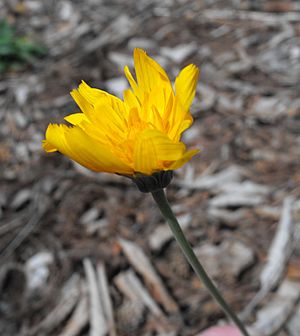Krigia facts for kids
Quick facts for kids Krigia |
|
|---|---|
 |
|
| Krigia biflora | |
| Scientific classification |
|
| Kingdom: | Plantae |
| Clade: | Tracheophytes |
| Clade: | Angiosperms |
| Clade: | Eudicots |
| Clade: | Asterids |
| Order: | Asterales |
| Family: | Asteraceae |
| Subfamily: | Cichorioideae |
| Tribe: | Cichorieae |
| Subtribe: | Microseridinae |
| Genus: | Krigia Schreb. |
| Type species | |
| Krigia virginica (L.) Willd.
|
|
| Synonyms | |
|
|
Krigia is a group of flowering plants found in North America. These plants are often called dwarf dandelions. They belong to the large Asteraceae family, which also includes sunflowers and regular dandelions.
Contents
About Dwarf Dandelions
Dwarf dandelions come in different shapes and sizes. Some are annual plants, meaning they live for only one growing season. Others are perennial herbs, which means they live for more than two years.
What They Look Like
Most dwarf dandelions grow from a system of thin roots or a single, thick taproot. One type even has underground stems called rhizomes with round storage parts called tubers.
These plants usually have one main stem, but some can have many, even up to 50 or more! They typically grow straight up, from just a few centimeters to about 75 centimeters tall. Most of their leaves grow near the bottom of the plant. However, some stems have leaves higher up. The leaves are often long and thin, or shaped like a spear. They can have jagged edges or be deeply cut into lobes. These leaves grow on stalks called petioles, which sometimes have wing-like edges.
Their Flowers
The flowers of dwarf dandelions grow in special clusters called flower heads. These heads look like a single flower but are actually made of many tiny flowers grouped together. They grow alone at the top of the stem or on stalks that come out from where the leaves meet the stem. Each flower head can have up to 60 small flowers, which are usually yellow or orange.
Seeds and Reproduction
After the flowers bloom, they produce small, dry fruits called cypselas. These fruits are smooth and have ridges. Sometimes, they also have a fluffy top called a pappus, which helps the seeds float away in the wind, just like a regular dandelion. This helps the plant spread its seeds and grow in new places.
Types of Dwarf Dandelions
There are several different kinds of Krigia plants. Here are some of the well-known species:
- Krigia biflora – This is known as the twoflower dwarfdandelion or orange dwarfdandelion. It grows across much of the eastern, central, and southwestern USA, and also in central Canada.
- Krigia caroliniana
- Krigia cespitosa – Often called the weedy dwarfdandelion or common dwarfdandelion. You can find it in the southeastern and south-central United States.
- Krigia dandelion – This one is known as the potato dwarfdandelion because of its tubers. It grows in the southeastern and south-central United States.
- Krigia integrifolia – Found in the Allegheny Mountains.
- Krigia montana – The mountain dwarfdandelion, which grows in the southern Appalachian Mountains.
- Krigia occidentalis – This is the western dwarfdandelion, found in the south-central USA.
- Krigia virginica – Known as the Virginia dwarfdandelion. It grows in the eastern and south-central United States, and also in Ontario and British Columbia, Canada.
- Krigia wrightii – Called Wright's dwarfdandelion, found in the south-central USA.
See also
 In Spanish: Krigia para niños
In Spanish: Krigia para niños

